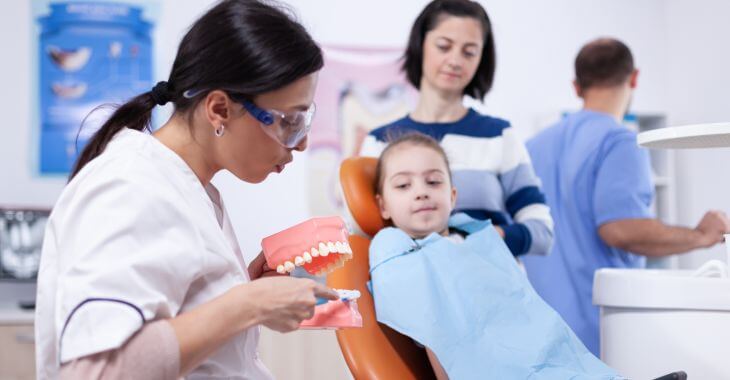Pulpotomy vs. Pulpectomy for Primary Teeth

If the pulp in a baby tooth is damaged, it may need to be removed. The pulp is inside the tooth under the dentin, and it protects the nerves of the tooth. If your child has a primary tooth with pulp damage, the pulp may need to be removed. What is the difference between a pulpotomy vs. pulpectomy?
Primary or baby teeth are susceptible to decay and trauma during the few years that they are in place. While they will eventually fall out, it is important that they stay in place until the adult or permanent teeth arrive. Pulpotomy treatment is often used to save a damaged primary tooth.
What is a Pulpotomy?
A pulpotomy is a procedure to remove damaged or inflamed pulp inside the tooth. This is usually done on primary or baby teeth when there is trauma or decay impacting the tooth. Since primary teeth are smaller, even a minor cavity can have an impact on the health of the pulp.
During a pulpotomy procedure, the affect pulp is removed from the crown or upper portion of the tooth. This procedure is only performed on live teeth that have not had nerve damage or infection that would require removing the pulp from the entire tooth down to the root.
In rare cases, pulpotomy may be performed on adult or secondary teeth. This usually is recommended when the adult tooth is not completely mature. This preserves the live tissue in the tooth and allows it to continue to grow and mature.
Pulpotomy procedures are only performed when the inflammation of the pulp or pulpitis is reversable. This means the dentist has determined the tooth is still alive and can recover from the damage. If the pulpitis is too severe, a pulpectomy or root canal procedure, or extraction may be needed.
What Is a Pulpectomy?
When comparing pulpotomy vs. pulpectomy, one of the main differences is whether the tooth is alive. When a tooth’s nerve is infected or no longer viable due to trauma, a pulpectomy may be performed. The tooth is dead, and the entire pulp is removed from the crown and root canals.
Most pulpectomy procedures are performed on adult teeth. If a primary tooth is dead, it may be worthwhile to have it extracted if the adult tooth will emerge soon. However, if removing the baby tooth could affect speech or oral development, a pulpectomy may be suggested to save the tooth.
Pulpectomy procedures are similar to root canal therapy. Both are performed on non-viable teeth and remove all the pulp and nerves from the canals. The difference is that root canal therapy also fills and seals the root canals, usually followed by placing a crown on the tooth.
Are Root Canals Performed on Baby Teeth?
Like pulpectomy procedures, root canal therapy may be recommended for a baby tooth. If severe decay occurs or infection in the tooth, a root canal can remove the nerves and pulp. This can stop tooth pain and save the tooth structure until it is ready to fall out.
Whether or not a primary tooth undergoes a root canal is similar to a pulpectomy. It depends on where the secondary tooth is in development and where it is located. Losing certain teeth too soon can result in misalignment of adult teeth and impact the child’s speech and oral function.
What to Expect During a Pulpotomy
Dentists, endodontists and pediatric dentists perform pulpotomy procedures on primary teeth and unmature adult teeth. This procedure requires specialized techniques to carefully remove the pulp inside the crown of the tooth that is damaged, while preserving the rest of the tooth.
During a pulpotomy, the tooth is completed numbed with a local anesthetic. The damaged pulp is removed from the tooth above the gum line, leaving the root canal intact. Once completed, the tooth is disinfected and sealed and may be covered with a dental crown to protect the tooth structure.
A pulpotomy does not remove the nerves like a pulpectomy or root canal. This means the nerves are still alive and they can be irritated after a pulpotomy. Anti-inflammatory and pain medications may be needed to relieve discomfort when the aesthesia wears off from the procedure.
Primary teeth that receive a pulpotomy should be monitored to ensure the pulpitis is gone and the tooth is healing. Most dentists will want to check the tooth every six months to ensure the tooth is recovering as expected. If the pulpitis moves into the roots, a pulpectomy, root canal or extraction is needed.

There are times when either a pulpotomy or pulpectomy may be recommended for primary teeth. This can keep the tooth alive and functional until the secondary tooth arrives. Talk to your dentist about all the options available if your child has a decayed or damaged baby tooth.
The information provided on this website, including text, graphics, images, and other materials, is intended solely for informational purposes and should not be used as a substitute for professional medical advice, diagnosis, or treatment.




)